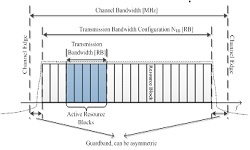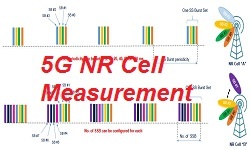3GPP 5G Advanced Features
Introduction
With the 3GPP release 15, foundation of basis 5G was laid with commercial deployments worldwide. Since then, 3GPP has been working on evolving the technology in releases 16 and 17 to improve performance further and address new use cases .
3GPP recently approved work items for its Release 18, which is considered as mark start of 5G Advanced evolution. In this blogpost , we will provide an overview of 5G Advanced w.r.t. 3GPP Release 18.
Evolution from 5G to 5G Advanced
In Release 15, 3GPP specified a new 5G air interface, known as New Radio (NR), aiming to address a
variety of usage scenarios from eMBB to URLLC to mMTC. NR supports both non-standalone (NSA) operation, which utilizes LTE for initial access and mobility handling, and standalone (SA) operation without relying on LTE. Key NR features include high-frequency operation and spectrum flexibility, ultra-lean design, forward compatibility, flexible duplex schemes, low-latency support, advanced antenna technologies, among others.
Release 16, the first step in the 5G evolution, introduces several major enhancements that improve existing features and address new use cases and deployment scenarios. Key improvements of existing features include MIMO and beamforming enhancements, enhanced DSS, reduced latency in dual connectivity and carrier aggregation, and UE power saving. The main new use cases and deployment scenarios addressed in Release 16 include enhanced support of industrial Internet of Things and URLLC, operation in unlicensed spectrum, V2X communications, positioning services, and integrated access and backhaul (IAB).
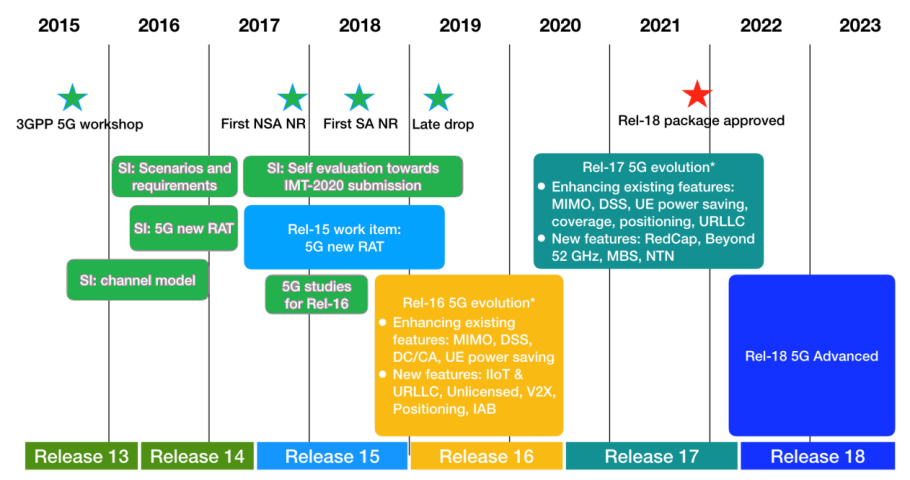
3GPP continues 5G evolution with Release 17 and further enhanced the existing features, such as MIMO, DSS, power saving, coverage, positioning, and URLLC. The main new use cases and deployment scenarios addressed in Release 17 include support for reduced capability (RedCap) UE, operation in frequency bands beyond 52 GHz, multicast and broadcast service, and non-terrestrial networks(NTNs).
Release 18 started the work for 5G Advanced. 3GPP approved its Release 18 study and work items during the December 2021 RAN plenary meeting. These items that will further boost network performance and address new use cases. In particular, utilizing the artificial intelligence (AI) and machine learning (ML) technologies in the evolution of 5G Advanced.
5G Advance Feature Categories
- 5G Performance Enhancements
- Flexible Spectrum Applications
- Diverse Devices
- Evolved Network
- Data and AI driven 5G
5G Performance Enhancement
3GPP will continue to add functionality in Release 18 to enhance 5G performance in the areas of network energy savings, coverage, mobility support, MIMO , MBS, and positioning.
Energy Saving
The momentum for saving network energy has grown remarkedly as energy cost has become a significant part of network OPEX. 5G NR is significantly more energy efficient in terms of energy consumption per bit than the previous generations technologies. However, due to the increasingly dense deployment of 5G networks, massive MIMO, much larger bandwidths, and support of more frequency bands, 5G networks would lead to higher energy consumption if proper energy-saving measures are not applied.
Therefore, 3GPP under release 18 has approved an study on network energy savings. The study aims to define a network energy consumption model for a base station, develop an evaluation methodology, and identify key performance indicators (KPIs).
Network Coverage
In Release 18, 3GPP plans to enhance the coverage of PRACH and study techniques to increase UE power limit for CA and DC and reduce maximum power reduction or peak-average-power ratio. In addition, dynamic switching between CP-OFDM and DFT-S-OFDM in the uplink will be studied.
Mobility
Mobility is a distinct feature of 5G networks which offers service continuity to moving UEs. When a UE moves from the coverage area of one cell to another, a handover process is initiated to change the serving cell for the UE. The serving cell change is currently based on layer 3 measurements and RRC signaling.
To reduce the latency, overhead, and interruption time associated with L3-based mobility management, 3GPP Release 18 will introduce mechanisms and procedures for layer 1/layer 2 based inter-cell mobility. Another major area for Release18 mobility work is to enhance further the support of conditional handover.
MIMO Evolution
MIMO will continues to evolve in 3GPP Release 18 . It is observed in commercial deployments that UE with medium or high mobility experiences significant performance loss in multi-user MIMO scenarios, partially due to outdated CSI information. Potential CSI reporting enhancements will be explored to improve performance for UE with medium or high mobility. Also, the work will study a larger number of orthogonal DMRS ports for MU-MIMO.
3GPP will extend the TCI framework to multi-TRP scenarios and study coherent joint transmission, two timing advances, and enhanced uplink power control for multi-TRP.
Multi Broadcast Service
MBS is a feature dedicated to delivering multicast and broadcast services efficiently. Use case examples include TV broadcasting, live video, software updates, and public safety usages. 3GPP specified the basic support for MBS in Release 17, enabling multicast transmission to UEs in RRC connected state and broadcast transmission to UEs in all RRC states.
3GPP Release 18 will extend the multicast support to UEs in RRC inactive state, introduce enhancements to enable UEs in RRC connected state to receive broadcast service and unicast service simultaneously, and study mechanisms to improve resource efficiency in RAN sharing scenarios.
Positioning
Positioning is a valuable service that can find applications in diverse 5G use cases. 3GPP Release 18 will investigate solutions to further improve accuracy, integrity, and power efficiency in positioning, study sidelink positioning, and investigate positioning support for RedCap devices.
Flexible Spectrum Applications
3GPP Release 18 will introduce further enhancements to enable more flexible and efficient spectrum use for 5G deployments in various scenarios with different spectrum allocations.
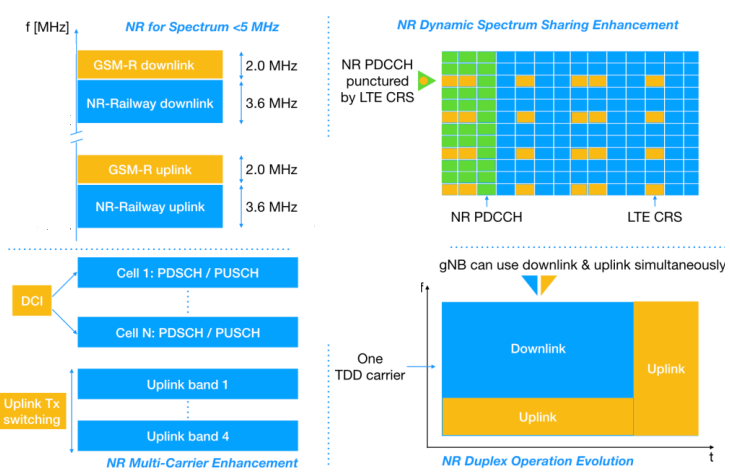
Lower Bandwidth Support
5G NR can support minimum channel bandwidth is 5 MHz. With growing interests in deploying NR in a dedicated spectrum with less than 5 MHz bandwidth available for NR. In Release 18, 3GPP will introduce necessary changes to NR to support deployments in spectrum allocations less than 5 MHz.
DSS Enhancement
DSS is a crucial 5G feature that enables a BS to use a shared spectrum to provide connectivity to both LTE UE and NR UE and facilitates the migration of the spectrum from LTE to NR. In DSS, PDCCH capacity is a bottleneck, because NR PDCCH and LTE PDCCH need to share the first three OFDM symbols within a slot and NR PDCCH cannot use symbols overlapping with LTE CRS.
In Release 18, 3GPP will study the possibility of allowing NR PDCCH to be transmitted in symbols overlapping with LTE CRS to increase the PDCCH capacity for DSS. Also, the feature of configuring UE with multiple LTE CRS rate matching patterns in multi-TRP will be made available to single TRP scenario to help mitigate intercell interference.
New DCIs
With evolving 5G NR, it is expected that more and more spectrum bands used by the previous generations networks will be refarmed to be used for 5G Advanced. The available spectrum blocks will likely be fragmented and scattered in different frequencies.
Aiming to utilize all the available spectrum efficiently, 3GPP Release 18 will introduce functionality to allows a single DCI to schedule multiple PDSCHs or PUSCHs across carriers.
Duplexing
TDD is widely used in commercial 5G deployments. Downlink and uplink can use the entire frequency spectrum in TDD, but the time domain resource is divided between downlink and uplink. NR supports TDD with semi-statically configured uplink/downlink configuration and dynamic TDD. If the time domain resource designated to uplink is limited, network performance such as coverage, capacity, and latency may be impacted.
To enable more flexible spectrum use, 3GPP Release 18 will study the feasibility of allowing the co-existence of downlink and uplink at the same time within a conventional TDD band. In other words, the duplex will become a mix of TDD and FDD. From a practical standpoint, since full duplex is not mature enough for commercial deployments, the study will restrict its scope to subband nonoverlapping full duplex at the 5G Node B (gNB) side. Besides, 3GPP Release 18 will study cross link interference handling to better support dynamic TDD in commercial deployments.
Diverse Devices
5G needs to serve diverse devices across eMBB, URLLC, and mMTC usage scenarios as shown in following figure.
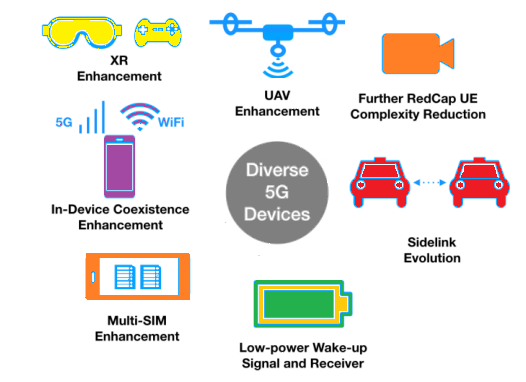
3GPP Release 18 will continue to study and introduce tailored functionalities to enhance and expand 5G capability to serve not only smartphones but also other diverse 5G devices, such as extended reality (XR) and cloud gaming devices, low-complexity UEs, vehicular devices, and uncrewed aerial vehicles (UAVs).
Multi RAT Devices
A smartphone typically supports multi RATs e.g., LTE and NR, and non-3GPP RATs, e.g., WiFi. The coexistence of a 3GPP RAT and non-3GPP RATs may lead to interference and cause an internal issue in device.
In-device coexistence is a feature that allows UE to indicate to its serving gNB that there is such a coexistence issue in the UE. The gNB can utilize the indicated information to restrict radio resource usage to help resolve the UE’s internal issue. 3GPP Release 18 will enhance the feature by allowing UE to indicate the affected frequencies with finer granularity and its preferred TDD pattern.
Multi-SIM Devices
A multi-SIM phone can be equipped with two independent SIM cards. When the UE is only connected to one network (e.g., network A) using one SIM card, the UE’s hardware resources can be dedicated to the communication with network A. Once the UE starts to connect to another network (e.g., network B) using the other SIM card, some of the hardware resources need to be used for communication with network B.
3GPP Release 18 will enable the multi-SIM UE to indicate its preferred capability restriction to network A when the UE needs to communicate with network B.
XR and Cloud Gaming Devices
In 3GPP Release 18, enhancements to better support XR and cloud gaming devices in NR networks is to be study. The traffic generated in XR and cloud gaming use cases is often quasi-periodic and requires high data rates and bounded latency simultaneously.
Besides, 3GPP will investigate how to make RAN more XR-aware, including identifying what application information is beneficial for RAN to be aware of and how to utilize the information in RAN to handle XR and cloud gaming traffic.
V2X and UAV Devices
3GPP continues to add functionality in Release 18 to enhance sidelink communication to support vehicular devices used in V2X services. One evolution objective is to increase sidelink data rate by adding the CA feature in sidelink communication. Besides, 3GPP will study mechanisms to support LTE V2X and NR V2X devices co-existing in the same frequency channel.
In addition to enhancing support for V2X devices on the ground, 3GPP Release 18 will introduce 5G NR support for devices onboard aerial vehicles, i.e., UAVs, whose applications are proliferating across many industries. Besides, the work will study enhancements for broadcasting UAV identification and signaling to indicate UAV beamforming capabilities.
Evolved Network
Resilient NG RAN
5G RAN supports splitting a gNB into two parts: a CU and one or more DUs. The gNB-CU can be further split into two parts CUCP and one or more CUUP . The logical gNB-CU-CP hosts the RRC and the CP part of the PDCP of the gNBCU. Failures at the gNB-CU-CP may disrupt its connected gNB-CU-UPs and gNB-DUs, which in turn can impact the served UEs. To enhance the resiliency of gNB-CU-CP, 3GPP Release 18 will study and identify gNB-CU-CP failure scenarios.
Integrated Access and Backhaul
IAB is a wireless backhaul solution based on NR. It serves as an alternative to fiber backhaul and thus can facilitate the deployment of mobile networks. An IAB node may consist of two parts: mobile-termination (MT) and DU. The MT connects the IAB node to its donor node, while the DU part can serve UEs and connect to other IAB nodes to create multi-hop wireless backhauling.
3GPP Release 18 continues to enhance NR-based IAB, focusing on the scenario where mobile IAB nodes are mounted on vehicles and provide 5G connectivity to UEs.
Repeaters
3GPP Release 18 will study NR network controlled repeater, which not only can amplify and forward the
received signals but also can receive side control information from the gNB. The examples of side control information include beamforming information, TDD configuration, power control information, among others. The study will identify which side control information is necessary, investigate needed L1/L2 signaling, and look into how to identify and authorize such network-controlled repeaters. Network coverage can also be extended by using a UE as a sidelink relay. The sidelink relay can be either a UE-to-network relay, where the relay UE connects a remote UE to the network, or a UE-to-UE relay, where the relay UE connects a first remote UE to a second remote UE.
Non-Terrestrial Networks
NTNs utilize satellites or high-altitude platforms (e.g., airplanes, balloons, and airships) to offer connectivity services. They can complement terrestrial networks by providing coverage in remote areas where terrestrial coverage is unavailable. 3GPP Release 18 will enhance NR operation over NTNs by improving coverage for handheld terminals, studying deployment above 10 GHz, investigating regulatory requirements for network verified UE location, and addressing mobility and service continuity between a terrestrial network and an NTN as well as between different NTNs.
Data and AI driven 5G
5G networks are becoming increasingly complex while generating humongous data. It is crucial to be data-driven and leverage AI techniques to manage the 5G networks efficiently.
3GPP Release 18 will not only enhance existing data collection features but also examine how AI techniques can improve air interface functions. 3GPP Release 18 will specify data collection enhancements and signaling support for a set of selective AI-based use cases, including network energy saving, load balancing, and mobility optimization.
3GPP Release 18 will also enhance NR data collection within the scope of the self-organizing network (SON)/minimization of drive testing (MDT). MDT enables operators to configure normal UEs to collect and report measurement data to reduce traditional drive tests. The Release-18 work will address SON features leftover from Release 17 and data collection for random access channel (RACH) optimization.
5G Advance Approved Item lists
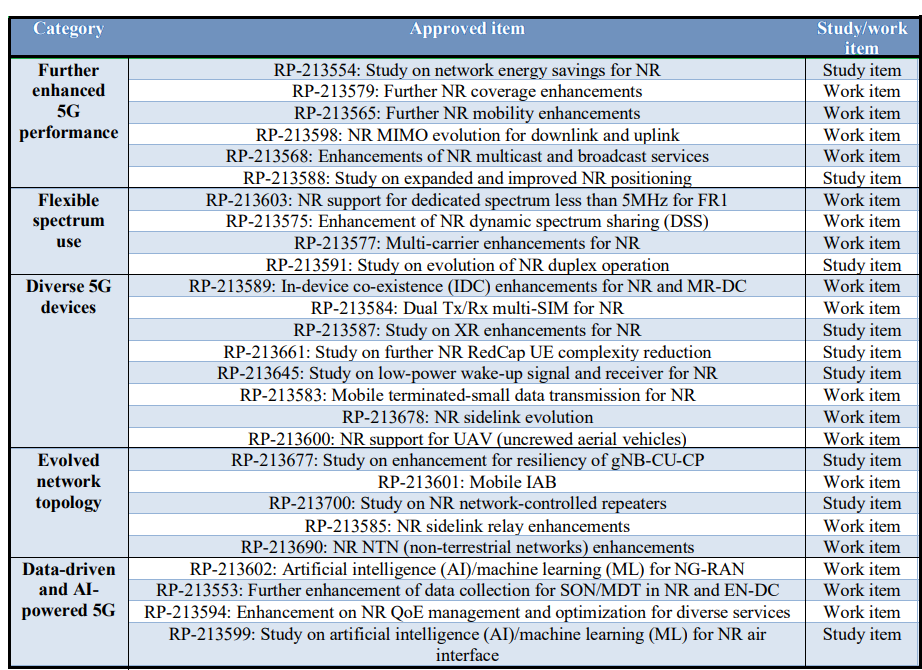
References
- Becoming 5G Advance – 5G America White Paper
- An Overview of 5G Advanced Evolution in 3GPP Release 18 paper
Related Posts
- 5G Reference Network Architecture
- 5G Network Sharing: Concept, Benefits and Architectures
- Hybrid Core Network – 4G Core to 5 G Core Interconnection
- Deployments Scenarios for 5G-NR
- Lawful Intercept (LI) in 5G System

